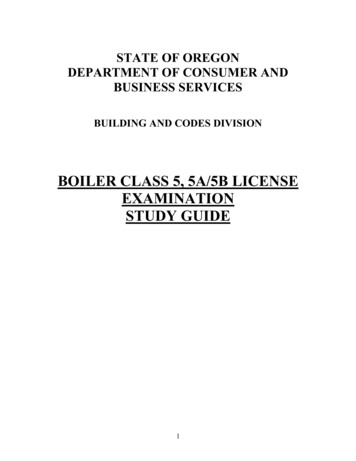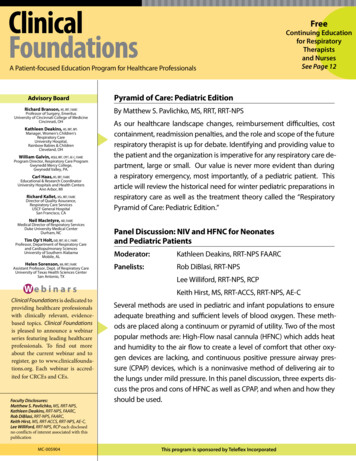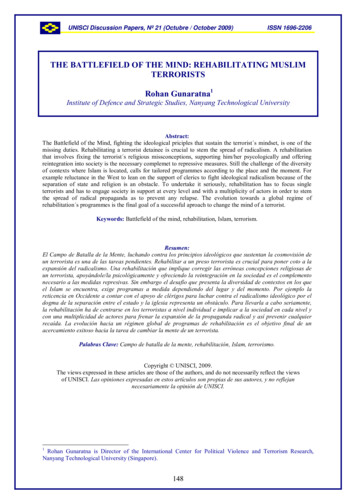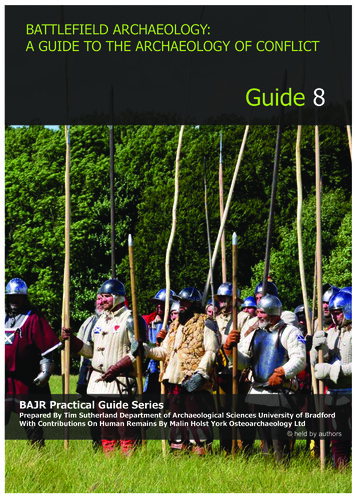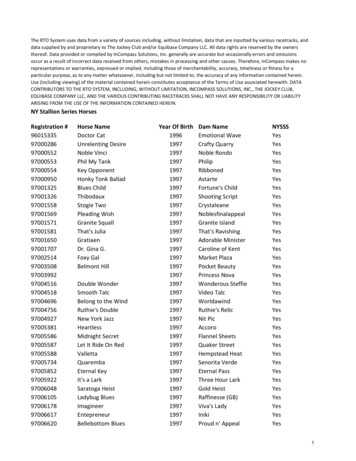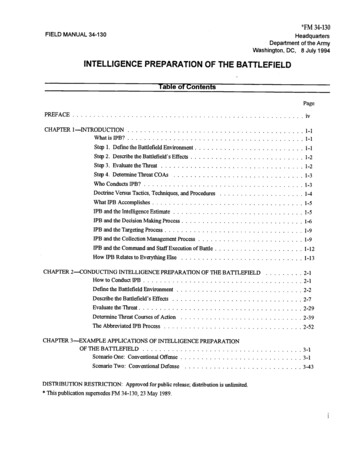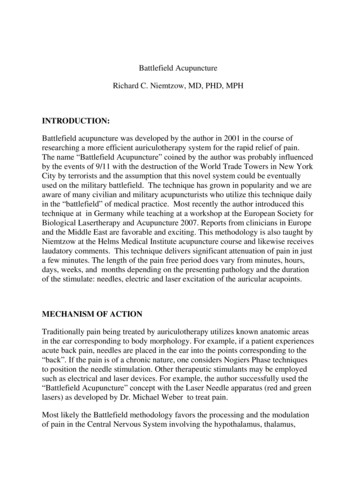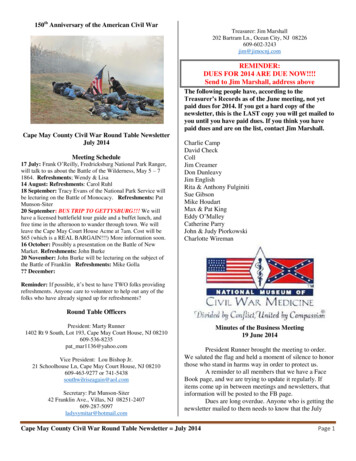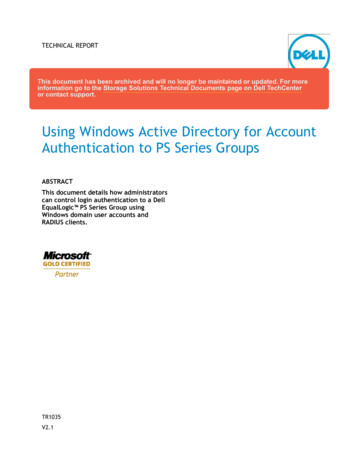
Transcription
Summer 1998Issue No. 70BATTLEFIELD UPDATEnewsletter of theAMERICAN BATTLEFIELD PROTECTION PROGRAMU.S. Department of the Interior National Park Service Heritage Preservation ServicesTRANSPORTATION L A W PROVIDES M I L L I O N S FOR PRESERVATIONThe Intermodal Surface TransportationEfficiency Act of 1991 (ISTEA) wasreauthorized by Congress on May 22and signed into law by President Clintonon June 9. Dubbed "TEA-21", theTransportation Equity Act for the 21 stCentury is a 217 billion, six-year publicworks bill that will provide funding forimprovements to highways and bridgesthroughout the country. The bill represents the largest increase in publiciworks spending in the nation's history.Of particular relevance to historicL preservation is the provision for fundingtransportation enhancement projects.'Funding for these types of projects is included in the law to complementintermodal transportation initiatives.'Many of the transportation enhancement activities allowed under the newlaw may directly benefit battlefields.These activities include "provision offacilities for pedestrians and bicycles,provision of safety and educationalactivities for pedestrians and bicyclists,acquisition of scenic easements andscenic or historic sites, scenic or historichighway programs (including the provision of tourist and welcome centerfacilities), landscaping and other scenicbeautification, historic preservation,rehabilitation and operation of historictransportation buildings, structures, orfacilities (including historic railroadfacilities and canals), preservation ofabandoned railway corridors (includingthe conversion and use thereof forpedestrian or bicycle trails), control andremoval of outdoor advertising, andarchaeological planning and research."Initial estimates indicate that transportation enhancement funds for TEA-21 willaverage 630 million annually, a 46.5%increase over ISTEA, which generatedroughly 430 million annually.According to The Civil War Trust,more than 50 Civil War projects in 12states have been funded with ISTEAmoney since 1991. Overall, 23.6 millionin ISTEA funds and 20.2 million inCharleston Conference SetPlease join the American Battlefield Protection Program and itspartners—the Association for the Preservation of Civil War Sites(APCWS), The Civil War Trust, and the National Conference ofState Historic Preservation Officers—for the Fourth National Conference on Battlefield Preservation in historic downtownCharleston, South Carolina, from September 16-19, 1998. Theconference, entitled "Defining Battlefields: Why, How, and WhatThen?" will explore the tools and techniques used to define historic battlefields, and effective methods of protecting battlefieldland. Sessions and workshops include nominating sites to theSee CONFERENCE, page 5matching funds have been used topreserve and interpret Civil War battlefields and sites. TEA-21 represents thelargest source of funding for battlefieldpreservation and enhancement projectscurrently available.The new law also makes specificappropriations for the Richmond andShenandoah Valley Civil War battlefields.TEA-21 provides 1 million in 1999 forthe National Park Service to rehabilitatethe historic Tredegar Iron Works, whichwill serve as a new visitor center forRichmond National Battlefield Park. TheShenandoah Valley Battlefields NationalHistoric District Commission will receive 500,000 over the next two years (appropriated from the Highway Trust Fund) todevelop a plan for the interpretation andprotection of 10 Civil War battlefields inthe Shenandoah Valley.For more information about TEA-21,please contact The Civil War Trust at(703) 516-4944 or your State HistoricPreservation Office.
CHANCELLORSVILLE ADDEDTO MOST ENDANGERED LISTThe National Trust for Historic Preservation recently unveiled this year's listof "America's 11 Most EndangeredHistoric Places." The ChancellorsvilleBattlefield, the scene of what manyCivil War historians consider to be Gen.Robert E. Lee's greatest victory, wasincluded on the list.The Chancellorsville Battlefield ispart of the Fredericksburg andSpotsylvania National Military Park inSpotsylvania County, one of the fastestgrowing counties in Virginia. Tire sitestraddles State Route 3, which is rapidlybeing lined with fast food restaurants,convenience stores, retail malls, andresidential subdivisions. According tothe National Trust, this proliferation ofsprawl-type development prompted theinclusion of the battlefield on this year'slist. Although the list is merely adesignation which carries no legalimplications, preservationists hope thatthe public awareness generated by thelist will spur citizens and governmentofficials into action. According to theNational Trust, since the inception of thelist in 1988, no site that has been namedto the list has been lost.Currently, only 1,944.5 acres of the21,874-acre Chancellorsville Battlefieldare protected. Most of the protectedparcels he within the core area of thebattlefield, where the heaviest fightingoccurred. The National Park Serviceowns 1,482 acres of the site, includingthe route of Lt. Gen. Thomas J. "Stonewall" Jackson's famous flanking march.However, approximately 5,600 acreswithin the core area of the battlefieldremain in private hands. The price ofland in the region has skyrocketed inrecent years, making acquisition ofbattlefield land more difficult for preservation groups and the National ParkService.The National Military Park and thenon-profit Central Virginia BattlefieldsTrust nominated Chancellorsville to the"Most Endangered" list. Both the parkand the land trust hope that the listingwill encourage Spotsylvania County andlocal landowners to take action to helpprotect endangered battlefield land.BATTLEFIELD UPDATEPublished by the National Park ServiceNEW MAGAZINE FEATURES NATIONALRobert StantonDirectorHISTORIC LANDMARKS{Catherine H. StevensonAssociate Director, Cultural Resourcesde Teel Patterson TillerChief, Heritage Preservation ServicesH. Bryan MitchellChief, American BattlefieldProtection ProgramTanya M. GossettEditorJeny BuckbinderProduction ManagerBattlefield Update is published quarterlyand is available free of charge. Sendarticles, news items, and correspondence tothe Editor, Battlefield Update, National ParkService, Heritage Preservation Services,American Battlefield Protection Program,1849 C Street, NW, (NC330) Washington, DC20240. PHONE (202) 343-3449; FAX (202)343-3921; EMAIL tgossett@hps.cr.nps.gov.The Heritage Preservation ServicesDivision of the National Park Service ispleased to present National HistoricLandmarks Network. This new publication was created for National HistoricLandmark (NHL) owners, managers, andfriends. It presents issues important to preserving the nation'smost significant historic sites.National HistoricLandmarks are sites ofnational significance tothe history of the UnitedStates that meet stringent criteria for integrity. There are currently2,248 NHLs, of which115 are battlefields orbattle-related sites.The magazine focuses on NHL protection activities taking place across the country and spotlights partnerships between the Nationalwmv2.cr.nps.gov/abpp/2Park Service and the stewards of thesehistoric sites. Contributors to Networkreport on current legislation, restorationcase studies, grants and other sourcesof financial assistance, technical assistance publications, andregional events andpreservation activitiesat NHLs.Network is published biannually and isfree of charge. To subscribe, please call thePublications Directorat (202) 343-9583 orwrite to the NationalPark Service, HeritagePreservation Services,1849 C Street, NW,(NC330) Washington,DC 20240. For moreinformation about theNationalHistoricLandmarks Survey and Assistance programs, please visit their Web site atwww2.cr.nps.gov/nhl/.
ARIZONA AND KENTUCKY SITES MAKENATIONAL REGISTERBetween March and May of 1998, one site associated withthe Indian Wars and two sites associated with the Civil Warwere listed in the National Register of Historic Places. TheState of Arizona nominated the Geronimo Surrender Site,which is significant to Arizona's military history. TheCommonwealth of Kentucky nominated the Danville NationalCemetery and the Mill Springs National Cemetery, bothestablished to commemorate soldiers who died in the CivilWar, as part of a state-wide effort to identify and recognizesuch sites.The Geronimo Surrender Site in Cochise County, Arizona,is the location where, on September 4, 1886, Apache leaderGeronimo and Brig. Gen. Nelson A. Miles of the U.S. Armyagreed to terms that ended hostilities between Chiricahua andWarm Springs Apaches and Americans in Arizona. Thistreaty is arguably the most significant accord signed betweenIndians and the United States government in Arizona, concluding a 40-year period of brutal warfare in the territory.Soon after Geronimo and Miles agreed upon the treaty, Capt.Henry W. Lawton erected a monument of rough stone tomark the location of the agreement. Originally ten feet acrossand six feet high, the now-crumbled monument overlooksSkeleton Canyon and a broad vista of the San Bernardino andSan Simon Valleys.The Danville National Cemetery in Boyle County,Kentucky, was established as a cemetery for Union soldiersduring the Civil War. In 1868, the U.S. War Departmentdeclared the site a national cemetery to commemoratesoldiers who died when Confederate Brig. Gen. JohnPegram's cavalry brigade captured Danville in March 1863.The cemetery's period of significance extends from the CivilWar through the 1950s. This cemetery is the final restingplace of 393 soldiers who died in many different wars andwho served in every branch of the armed services.The 3.5-acre Mill Springs National Cemetery contains theremains of Union soldiers killed during the Battle of MillSprings in January 1862, as well as soldiers who served in theU.S. Army from the Civil War through the 20th century. TheUnion victory at Mill Springs broke the Confederate defensiveline across Kentucky, leaving all of eastern Kentucky in Unionhands and opening the way for the invasion of pro-Unioneastern Tennessee. In addition to the original battle casualties, Union soldiers who died within 50 miles of the battlefieldwere buried in the cemetery, including soldiers who died inlocal hospitals after the battle or were killed in skirmishes.The cemetery's post-Civil War interments included a BuffaloSoldier who received the Medal of Honor for heroism in theIndian Wars and veterans of both World Wars.3 tr:.M-iW* Al ti*S&f ti&fr:t. jfi*t- Mill Springs National Cemetery. NRHP File Photo.The National Register is the nation's official list of culturalresources worthy of preservation. Sites listed in the NationalRegister are recognized as being significant to the nation, astate, or a community; are considered in the planning forFederal or federally assisted projects; are eligible for Federaltax benefits; and may qualify for Federal assistance for historic preservation when funds are available.O N THE HILLOn June 15, 1998, the Senate passed a non-bindingresolution that reiterated the Senate's continued interestin Revolutionary War, War of 1812, and Civil Warbattlefield preservation. The Senate recommended thatfunds be made available in the FY99 Federal budget to1) conduct the Revolutionary War and War of 1812Historic Preservation Study, and 2) earmark Land andWater Conservation Fund monies for acquisition of CivilWar battlefield lands endangered by urban and suburbandevelopment. If the House agrees to the resolution, theresulting Sense of Congress resolution could guide FY99appropriations for battlefield preservation.Following closely on the heels of the resolution, the SenateAppropriations Committee made its initial, draft mark-upsto the President's Proposed FY99 Budget for theDepartment of the Interior. The committee included 3 75,000 to begin the Revolutionary War and War of 1812Historic Preservation Study. The House Committee onAppropriations did not include funding for the study in itsmark-ups. As Battlefield Update goes to press, neitherfull house has acted on the FY99 Budget.
PARTNERSHIP PROTECTS LANDAT PILOT KNOBForty acres of hallowed ground on thePilot Knob battlefield in Iron County,Missouri, have been added to the FortDavidson State Historic Site. Thisannouncement, made April 3,1998,came from the partners who worked topurchase the land, i.e. TheConservation Fund, The Civil WarTrust, the Committee to Preserve andProtect Pilot Knob Battlefield, TheGilder Foundation, and the MissouriDepartment of Natural Resources. TheArcadia Valley Chamber of Commerceand the St. Louis Civil War RoundTable also contributed to the project.The newly purchased 40-acre plot liesadjacent to Fort Davidson and morethan doubles the size of the historic site.Each of the partner groups expressed its deep satisfaction with thecombined accomplishment and noted itsimportance to the community. SteveMahfood, Director of the MissouriDepartment of Natural Resources,remarked, "We are excited about thiscooperative effort to preserve more ofthe undeveloped area of the battlefield.This addition lies within the view fromthe rampart of Fort Davidson and willenhance visitors' understanding of thebattle." Rita Henroid, Chair of the IronCounty Committee to Preserve andProtect Pilot Knob Battlefield, added,"The people of Iron County are committed to preserving [this] historic land andto honoring the soldiers who fought anddied in the battle."The Battle of Pilot Knob occurredin September 1864. A Confederatearmy under Maj. Gen. Sterling Pricecrossed into Missouri with the goal ofcapturing St. Louis. On September 17,near Pilot Knob Mountain, Price attacked the Federal garrison at FortDavidson. In the late afternoon, Price'smen repeatedly but unsuccessfullyassaulted the fort, suffering heavycasualties. During the night, theFederals evacuated the fort. Price paida heavy price in manpower and time forhis victory at Pilot Knob. Union forcesgained the necessary time to concentrate and defend St. Louis, whichdissuaded Price from attacking the city.For more information aboutpreservation at Pilot Knob, contact TheConservation Fund, 1800 North KentStreet, Suite 1120, Arlington, VA 22209,(703) 683-2996, or Rita Henroid, IronCounty Economical DevelopmentCoordinator, 250 South Main Street,Ironton, MO 63650, (573) 546-7690.reproductions of clothing, medicalequipment, weapons, and accouterments such as those employed duringthe battle. The Civil War Round Tableof Kansas City is sponsoring the projectand raising the funds required to providethese much needed items to the MineCreek collection.For additional information about theMine Creek Battlefield VisitorsInformation Center, contact site curatorKip Lindberg at (913) 795-4365. Tolearn how you can help sponsor exhibitroom development, please contact theCivil War Round Table of Kansas Cityat (913) 648-2517 or (913) 649-5040.MINE CREEK VISITORSCENTER UNDERCONSTRUCTIONAWARDAVINNING PLANCOMPLETED FORCONFEDERATE WORKSOn April 1, 1998, construction began ona permanent Visitors InformationCenter at the Mine Creek BattlefieldState Historic Site in Linn County,Kansas. The Kansas State HistoricalSociety, which operates the site,expects that the facility will open byNovember 1998.The new facility will enable visitorsto understand better what occurred onthis ground in October 1864. About sixmiles south of Trading Post, Kansas,two brigades of Maj. Gen. AlfredPleasonton's Provisional CavalryDivision overtook Maj. Gen. SterlingPrice's rearguard as it crossed MineCreek. The Southerners formed up onthe north side of the creek. Althoughoutnumbered, the Federals attacked.Additional troops from Pleasonton'scommand arrived during the fight.They soon surrounded the Confederatesand ultimately captured about 600 menand two generals, Brig. Gen. John S.Marmaduke and Brig. Gen. William L.Cabell.A large exhibit room within the newVisitors Center will contain authentic4The Lost Mountain to BrushyMountain Earthworks PreservationPlan has been completed and published.Funded by the American BattlefieldProtection Program, the plan identifiesand maps 13 study areas of existingConfederate earthworks along a sevenmile front and recommends preservationand interpretation treatments for majorsections of the defensive lines. Themaps, produced in a GeographicInformation System, convey the environmental, cultural, and land useopportunities and constraints that existat each of the remaining earthworksections.The 45-page EarthworksPreservation Plan was prepared forKennesaw Mountain NationalBattlefield Park by ED AW, Inc., aplanning firm based in Atlanta, Georgia.The plan earned the prestigious HonorAward from the Georgia Chapter of theAmerican Society of LandscapeArchitects, and has already beenadopted as part of the Cobb CountyComprehensive Land Use Plan.
CONFERENCE, from page 1National Register of I listoric Places, using archeology to define and protect battlefield land, identifying and documenting navalbattle sites, and using different types of survey data to produce preservation plans and protect battlefield land. Preservationists,community planners, archeologists, government officials, and battlefield landowners, managers, and enthusiasts arc encouragedto attend the conference.On Wednesday, September 16, the APCWS will host a workshop exploring the entire process of acquiring battlefield propertyfor preservation purposes. On Friday, September 18, The Civil War Trust will host a workshop that will detail the intricacies andopportunities of TEA-21 (seepage 1) and provide guidance to participants interested in applying for TEA-21 funding. On Fridayevening, the ABPP will host a tour of Fort Sumter and a dinner cruise on Charleston Harbor. On Saturday, September 19,attendees may choose between a tour of Revolutionary War sites near Charleston or a tour of Civil War sites on James Island. TheRevolutionary War tour is tentatively scheduled to include Fort Moultrie, Old Dorchester, Biggin Church, and Moncks Corner.The Civil War tour will stop at Secessionville, Fort Johnson, Battery Tynes, and Battery Pringle.The conference will be held at the Westin Francis Marion Hotel, at King and Calhoun Streets in Charleston's historic district. Theroom rate for the conference is 129 per night. To make hotel reservations call (843) 722-0600 and mention that you will beattending the "Battlefield Preservation Conference". The deadline for hotel reservations is August 15, 1998.The registration fee for the Fourth National Conference on Battlefield Preservation is 90. This fee entitles registrants toparticipate in Thursday and Friday conference sessions, the Friday evening Fort Sumter tour and dinner cruise, and a Saturdaytour. The conference registration deadline is August 21, 1998. Registration forms are available from the ABPP and theABPP web site (www2.cr.nps.gov/abpp/conference98.htm). Please call Hampton Tucker at (202) 343-3580 or Jeff Everett at(202) 343-2331 for additional information.The events of June 1864 broughtthe Civil War to Cobb County, Georgia.Maj. Gen. William T. Sherman'sFederals were moving inexorably toward Atlanta, while Gen. Joseph E.Johnston's Confederates doggedlyattempted to slow the Union army'sprogress. In early June, Johnston established a defensive line of fortificationsthat ran for ten unbroken miles fromBrushy Mountain to Lost Mountain. Ina series of direct assaults and flankingmaneuvers (the battles of PineMountain, Gilgal Church, NoondayCreek, and Kolb's Farm) that occurredbetween June 14-17, Sherman's armycompelled the Confederates to withdraw from the Brushy Mountain to LostMountain line. Johnston's army thentook up new positions astride KennesawMountain.If you would like to receive a copyof the Earthworks Preservation Plan,contact Kennesaw Mountain NationalBattlefield Park, 905 KennesawMountain Drive, Kennesaw, GA 30152,(770)427-4686.MARLAND LAUNCHESWAR OF 1812 PROJECTOn May 22, 1998, the State ofMaryland kicked off an interpretationand education project to helpMarylanders and visitors to the stateunderstand the important role the Warof 1812 played in the history of thenation. Maryland hopes to emulateVirginia's successful Civil War Trailsheritage tourism program to drawvisitors to the state's War of 1812 sites.The Maryland Office of TourismDevelopment, the Maryland HistoricalTrust, and the Maryland Office ofCultural Resources lead this initiative,which relies on partnerships betweenthe state, the National Park Service,5county tourism offices, and publicly andprivately owned historic sites. TheState has offered to assist individualhistoric sites in developing museumexhibits and outdoor interpretativewaysides, to produce and distributepromotional literature about the war,and to help local governments andprivate organizations establish new,publicly accessible sites. Marylandofficials believe this project will havestrong appeal to both American andBritish visitors.Maryland, while most famous forthe Baltimore Riots in June and July1812 and the bombardment of FortMcllenry in September 1814, boasts 75heritage tourism sites associated withMr. Madison's War.For more information about theMaryland War of 1812 StatewideInitiative, please contact BarbaraStewart of the Maryland HistoricalTrust at (410) 586-8531.
Moccasin Bend and the City of Chattanoogafrom Lookout Mountain, ABPP Photo.Battlefield Preservation Profile2,700 acres of the battlefield (the boundaries of the park) were listed in theNational Register of Historic Places. Nohistorically significant land has been addedto the park in more than 50 years.The Secretary of the Interior established the American Battlefield ProtectionProgram (ABPP) in 1990. That same year,Congress and the Secretary appointed theCivil War Sites Advisory Commission tostudy and rank the nation's Civil War battlefields. In the 1993 Civil War SitesAdvisory Commission Report, the Chattanooga Battlefield was identified as oneof this country's top 50 priority battlefieldsites for preservation.Recent preservation activities at the site include The CivilWar Trust's adding the site to its Civil War Discovery Trail in1995. In 1996, the ABPP funded the Chattanooga Area CivilWar Sites Assessment (CACWSA), a joint effort of the community and the park to identify and encourage the protectionof Civil War battlefield resources located outside the park'sboundaries.Last year the ABPP awarded two grants to facilitate preservation activity as recommended by the CACWSA. TheFriends of Moccasin Bend National Park, Inc., received agrant to identify and evaluate significant battlefield featureswithin Moccasin Bend, prepare a report describing activitiesthere that were key to the Chattanooga Campaign, and provide preservation and interpretation recommendations for CivilWar resources at the site. The second grant was awarded toReflection Riding, a 300-acre botanical park, historical site,and nature preserve, to evaluate cultural resources on theportions of the Lookout Mountain and Wauhatchie battlefieldsthat it owns.CHATTANOOGA, TENNESSEEAfter his defeat at Chickamauga, Georgia, in September1863, an unnerved Union Brig. Gen. William S. Rosecransordered his Army of the Cumberland to withdraw toChattanooga. The city, captured by the Union earlier thatSeptember, was the hub of several railroads providing accessto all parts of the Confederacy. Concerned about the situationat Chattanooga, in October, President Lincoln ordered UnionGen. Ulysses S. Grant to take control of the Federal armiesin the West. Grant removed Rosecrans as commander of theArmy of the Cumberland, installed Brig. Gen. George H.Thomas in Rosecrans' place, and immediately undertook stepsto raise the Confederate siege of Chattanooga. Gen. BraxtonBragg's Confederates were deployed on and along LookoutMountain and Missionary Ridge, south and east ofChattanooga. From these positions, the Confederatesthreatened both the city and its supply lines along the TennesseeRiver. Bragg planned to hold the city under siege and forcethe Union troops out of Tennessee. Nevertheless, Grant wasable to open a supply line to the city from the west that allowedhim to mount an offensive against the Confederates onNovember 23-25. The ensuing Union victory lifted the siegeof the city and decimated the morale of the Confederacy.Chattanooga's railroads became the Union's gateway into theDeep South.Preservation at the site began in 1890 when Congressestablished the Chickamauga and Chattanooga NationalMilitary Park to commemorate the battle. Small portions ofthe battlefields were purchased and, over the next 20 years,various veterans groups and state commissions installed numerous monuments on these small battlefield reservations. Inthe 1930's, local residents donated more than 2,400 acres onLookout Mountain to the National Park Service. In 1966,Today 2,700 acres of this 25,429-acre*battlefield are protected.For more information on the protection of this site, contactJim Ogden, Historian, Chickamauga and ChattanoogaNational Military Park, P.O. Box 2128, Fort Oglethorpe, GA30742, or call (423) 752-5213 ext. 116.* This acreage represents the study area of the battlefield defined in a surveycompleted as part of the 1993 Civil War Sites Advisory Commission Report,6
LITERATURE & INFORMATIONNOTICESA third edition of The Civil War Trust'sOfficial Guide to the Civil WarDiscovery Trail is now available. Completely revised and updated, this editionincludes four more states and 94 new sitesfor Civil War visitors to add to their itineraries. A Frommer's Guide publishedby Macmillan, the 320-page OfficialGuide includes site descriptions, statemaps, and illustrations.The Official Guide describes morethan 500 Civil War sites in 28 states. Italso provides invaluable travel information, including exact directions to the sites,admission fees, seasons and hours, visitor services, detailed and accurateorientation maps, and reenactments andspecial events schedules.A portion of the proceeds from salesof the Official Guide will be used forbattlefield preservation. To order theguide book ( 13.95 plus shipping and handling), call 1-888-CW-TRAIL.To compliment the Official Guide,Civil War Discovery Trail sponsorCracker Barrel Old Country Store, Inc.,has produced a new, full-color Discovery Trail brochure. On one side of thebrochure, a national map indicates the locations of all sites participating in theDiscovery Trail and provides a telephonenumber for each. The reverse side ofthe brochure is filled with insights intosuch topics as the Underground Railroadand Civil War technology, and facts aboutfamous Civil War figures such asFrederick Douglas and Belle Boyd .Please contact The Civil War Trustat (703) 516-4944 or 2101 WilsonBoulevard, Suite 1120, Arlington, VA22201 to order the Discovery Trail brochure.The Fifth Annual Texas Civil WarPreservation Seminar "Two GreatArmies" will be held on November 21,1998. This year's seminar features speakers Ed Bearss, National Park ServiceHistorian Emeritus, Dr. Gary Gallagher,acclaimed scholar and author from Pennsylvania State University, and Dr. Richard McMurry, noted historian and author.The seminar will be held at theCentral Texas campus of Hill College inHillsboro, Texas, with two-thirds of theproceeds from this conference going toward Civil War battlefield preservation.For information on attending this seminar, please contact Daniel M. Laney, CoChairman and President, Austin Civil WarRound Table, 2302 Cypress Point West,Austin, TX 78746, (512) 306-9933 orBuddy Patterson, Co-Chairman andDirector, Harold B. Simpson HistoryComplex, Hill College, 112 Lamar,Hillsboro, TX 76645, (254) 582-2555 ext.242.The Chicago Historical Society will beholding its Second Annual Symposiumentitled "The Experience andMeaning of Combat in the Civil War"on Friday, September 25,1998, at its headquarters on North Clark Street, Chicago,Illinois.Six speakers will address this topic asit applied to the common soldier, women,African-Americans, and Native Americans. Several special events are alsoplanned, including a living history program,a Civil War encampment, and a book signing session at the Abraham Lincoln BookShop.Fees for the symposium are 35 withan additional 10 charge for those whowish to purchase a boxed lunch. For moreinformation, contact Lorrain Mason,Chicago Historical Society, 1601 NorthClark Street, Chicago, IL 60614, (312)642-5035 ext. 272.7The Chrysler Museum of Art, in Norfolk,Virginia, is currently holding an exhibitionentitled "Sacred Sites, Civil War, Thenand Now". The exhibit, which runs untilAugust 30, 1998, features the works ofmany well-known Civil War photographers and artists including MatthewBrady, Alexander Gardner, WinslowHomer, Edouard Manet, and JimMcElhinney.According to the museum, the exhibitincludes more than 200 historic and contemporary works of art, many from rarelyseen public and private collections. Eyewitness views are presented through amyriad of original photographs, paintings,watercolors, and drawings. Contemporary renderings of the same sacred sites,created by some of today's most exceptional artists, combine with the historicimages to present a novel juxtaposition ofpast and present.For more information about the exhibit, call Chrysler Museum CuratorBrooks Johnson at (757) 664-6200.
National Park ServiceHeritage Preservation ServicesAmerican Battlefield Protection Program1849 CSt, NW(NC330)Washington, DC 20240FIRST CLASS MAILPOSTAGE AND FEES PAIDUSDI-NPSPERMIT No. G-83OFFICIAL BUSINESSPENALTY FOR PRIVATE USE 300Regulations ofPrograms on thdiscriminated aOpportunity Prdepartmental Federally Assisted/es he or she has been;e to: Director, EqualW , Washington, DC 20240.www2.cr.nps.gov/abpp/
San Simon Valleys. The Danville National Cemetery in Boyle County, Kentucky, was established as a cemetery for Union soldiers during the Civil War. In 1868, the U.S. War Department declared the site a national cemetery to commemorate soldiers who died when Confederate Brig. Gen. John Pegram's cavalry brigade captured Danville in March 1863.
